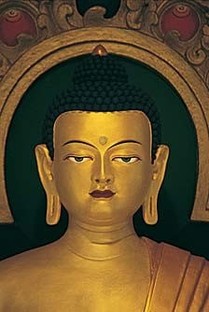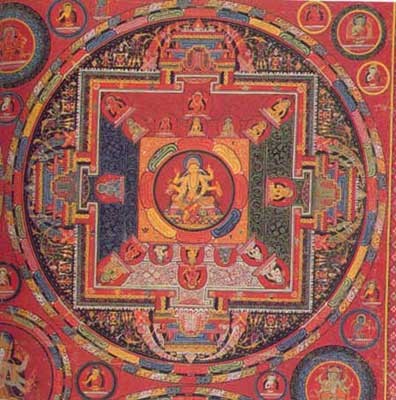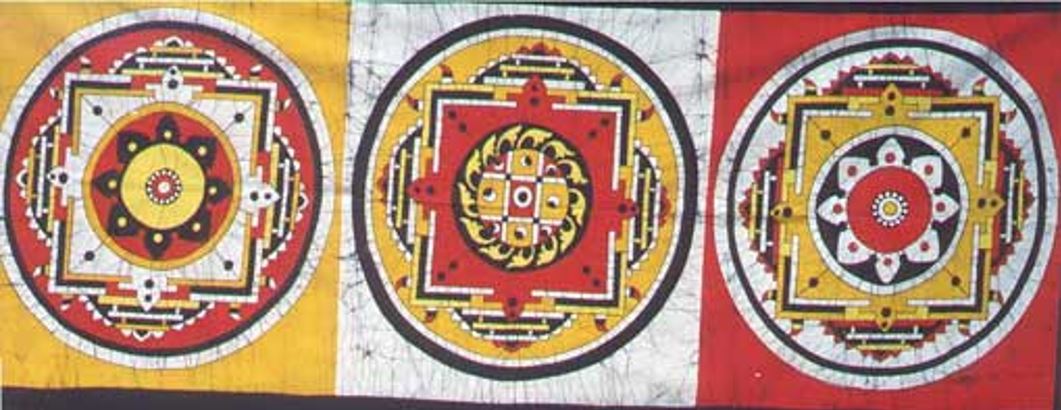Tibetan Buddhism - Mayhayana
|
Origin / Stories
In about 560BC, Siddhartha Gautama was born into a Hindu family to the north of India. Gautama's father brought him up in a very sheltered environment. He was installed in the palace, and later married and had a son. However, as Gautama rode through the park surrounding his palace one day, he saw a man covered with terrible sores, another tottering with age, a corpse being carried to its grave, and a begging monk who appeared to be peaceful and happy. The last sight caused him to reconsider his life of luxury and he left the palace and his wife, shaved his head, put on a yellow robe and became a wandering beggar-monk. Gautama studied the Upanishads with the help of the finest Hindu teachers, but found no satisfactory answer. He then starved himself in an effort to find salvation through self-denial - but this brought him no happiness either. He then sat under a tree for forty days and nights, determined not to move until he found what he had been searching for. Mara (the evil one) tried to make him give up his quest, but he persevered, and at the end of the forty days, he experienced 'nirvana'. From then on, he was known as 'Buddha' or 'the enlightened one'. Gautama then re-entered society, where he began preaching and teaching about the way of salvation that he had discovered. He founded an order of monks and, in the remaining forty-five years of his life saw many thousands turn to his religion. Scriptures / Texts Buddhism has three kinds of Scriptures. There are disciplinary rules, often in story form; sermons and sayings attributed to Buddha; and dogmatic treatises. But Buddhists do not regard these as 'revealed writings' as other religions claim for their scriptures. Beliefs Buddhism has developed into many different forms, with two main division. 'Theravada Buddhism' emphasises the monastic life, and monks regard Guatama Buddha as the great teacher whose way they must follow to reach nirvana - 'Theravada' means 'the way of the elders'. This branch of Buddhism has become wealthy through gifts of land and money for monasteries. It is dominant today in Sri Lanka, Burma, Thailand, Kampuchea, and Laos. 'Mahayana Buddhism' (the doctrine of the greater way) teaches that Buddha believed salvation is for all people. It claims that because Buddha stayed on earth for forty-five years instead of going to nirvana, he must have stayed to save mankind. Mahayana Buddhism is popular in China, Tibet, Japan, Vietnam and Korea. Zen Buddhism also comes within the scope of Mahayana and emphasises meditation and intuition. |
Symbols
The Buddha and the Eight spoke wheel. Whatever form Buddhism takes, the essential belief remains the same - that man's supreme purpose in life is to achieve nirvana. Buddha claimed that his mission was to show man the way to escape suffering in life - not to describe what he would find once he had been liberated. The closest he came to explaining nirvana was to say that it is a state of having lost all desire, and is achieved when karma (the duties of life) and the succession of lives and births (reincarnation) have been finally overcome.
Buddha differed from Hinduism in that he offered a precise definition of man's problem, and set out an exact plan of salvation. More than that, he made salvation possible for everyone, regardless of class or caste. Man's problem is summed up in the 'Four Noble Truths'. 1. Suffering is universal. The very act of living must include suffering, and in each of a person's incarnations, he must suffer. Nirvana is release from this unending cycle of suffering. 2. The cause of suffering is craving. Man is trapped in this unending cycle because he is too attached to the world by his selfish desire or 'tanha'. 3. The cure for suffering is to eliminate craving. This was Buddha's greatest discovery: if a person could put an end to craving he would put an end to suffering. 4. Eliminate craving by following the Middle Way. The system by which man could eliminate craving was set out by Buddha in what he called the 'Noble Eightfold Path'. Ethics The eightfold path consists of the following: (1) Right belief; (2) Right aspiration; (3) Right speech; (4) Right behaviour; (5) Right occupation; (6) Right effort; (7) Right mindfulness; (8) Right meditation. Social Structure There are also ten precepts which help clarify the Eightfold Path. Five are for laymen; they prohibit killing, stealing, sexual misconduct; lying, drinking intoxicating liquor. Another five apply to monastic novices and committed laity; who are not to eat during prohibited hours; not to take part in festivals and amusements; not to use garlands, perfumes, ointments; not to use a bed or a chair too large or luxurious; not to accept money for themselves. Tantric Buddhism in Australia http://www.australiantibetanbuddhistcentre.org.au/index.html http://www.drolkarbuddhistcentre.org.au/ |
The BBC has an introductory site to Buddhism
http://www.bbc.co.uk/religion/religions/buddhism/index.shtml
This is helpful in understanding the various type of Buddhism. The Sand Mandala is a Tibetan Buddhist practice
Time Lapse Making of a Mandala: The Crow Collection of Asian Art |
Tibetan Sand Mandala Creation & Dissolution Ceremony |
|
|
|
| sandmandalainclasstime.docx | |
| File Size: | 13 kb |
| File Type: | docx |
Mandala Sand Painting
|
According to Buddhist scripture, mandalas (geometric designs symbolic of the universe) constructed from sand transmit positive energies to the environment and to the people who view them. They are believed to affect purification and healing. Mandala sand painting was introduced by the Buddha himself and there are many different designs of mandala, each with different lessons to teach.
The mandala sand painting process begins with an opening ceremony, during which the lamas consecrate the site and call forth the forces of goodness. The monks chant and dance in resplendent dress. The design of the mandala is marked with chalk on a wooden platform and as this is such a meticulous process takes the whole of the first day. Then starting from the centre and concentrically working outwards, the monks use metal funnels called chak-pur to place millions of grains of dyed sand to make the elaborate patterns. The vibrations of the chak-pur being grated with a metal rod cause the sands to flow like liquid. The sand used at Manchester Town Hall was actually ground marble from Southern India. Other popular substances are powdered flowers and herbs or grains. In ancient times powdered precious and semi precious gems were also used. The mandala represents an imaginary palace that is contemplated during meditation. Each object in the palace has significance, representing an aspect of wisdom or reminding the meditator of a guiding principle. The mandala's purpose is to help transform ordinary minds into enlightened ones and to assist with healing. The Tibetan mandala contains deities, with the principal deity in the centre of the pattern. The deities who reside in the palace embody philosophical views and serve as role models. |
Once the mandala is complete the monks ask for the deities' healing blessings during a ceremony. As the monks chant, one monk begins the destruction of the mandala by scraping a knuckle through the sand creating a cross of grey sand. Another monk uses a paintbrush to slowly and carefully sweep the sand from the perimeter to the centre of the mandala. The destruction of the mandala servers to remind one of the impermanence of life.
The coloured sand is swept up into an urn and dispersed into flowing water - a way of extending the healing powers to the whole world. It is seen as a gift to the mother earth to re-energise the environment and universe. Both broadly define mandalas as geometric designs intended to symbolize the universe, and reference is made to their use in Buddhist and Hindu practices. For more detail on the construction including the significance of the colours see this website By http://www.exoticindiaart.com/article/mandala/ or download the pdf here
| ||||||
The mandala idea originated long ago before the idea of history itself. In the earliest level of India or even Indo-European religion, in the Rig Veda and its associated literature, mandala is the term for a chapter, a collection of mantras or verse hymns chanted in Vedic ceremonies, perhaps coming from the sense of round, as in a round of songs. The universe was believed to originate from these hymns, whose sacred sounds contained the genetic patterns of beings and things, so there is already a clear sense of mandala as world-model.
The word mandala itself is derived from the root manda, which means essence, to which the suffix la, meaning container, has been added. Thus, one obvious connotation of mandala is that it is a container of essence. As an image, a mandala may symbolize both the mind and the body of the Buddha. In esoteric Buddhism the principle in the mandala is the presence of the Buddha in it, but images of deities are not necessary. They may be presented either as a wheel, a tree, or a jewel, or in any other symbolic manifestation.
The origin of the mandala is the centre, a dot. It is a symbol apparently free of dimensions. It means a 'seed', 'sperm', 'drop', the salient starting point. It is the gathering centre in which the outside energies are drawn, and in the act of drawing the forces, the devotee's own energies unfold and are also drawn. Thus it represents the outer and inner spaces. Its purpose is to remove the object-subject dichotomy. In the process, the mandala is consecrated to a deity.
In its creation, a line materializes out of a dot. Other lines are drawn until they intersect, creating triangular geometrical patterns. The circle drawn around stands for the dynamic consciousness of the initiated. The outlying square symbolizes the physical world bound in four directions, represented by the four gates; and the midmost or central area is the residence of the deity. Thus the centre is visualized as the essence and the circumference as grasping, thus in its complete picture a mandala means grasping the essence.
The word mandala itself is derived from the root manda, which means essence, to which the suffix la, meaning container, has been added. Thus, one obvious connotation of mandala is that it is a container of essence. As an image, a mandala may symbolize both the mind and the body of the Buddha. In esoteric Buddhism the principle in the mandala is the presence of the Buddha in it, but images of deities are not necessary. They may be presented either as a wheel, a tree, or a jewel, or in any other symbolic manifestation.
The origin of the mandala is the centre, a dot. It is a symbol apparently free of dimensions. It means a 'seed', 'sperm', 'drop', the salient starting point. It is the gathering centre in which the outside energies are drawn, and in the act of drawing the forces, the devotee's own energies unfold and are also drawn. Thus it represents the outer and inner spaces. Its purpose is to remove the object-subject dichotomy. In the process, the mandala is consecrated to a deity.
In its creation, a line materializes out of a dot. Other lines are drawn until they intersect, creating triangular geometrical patterns. The circle drawn around stands for the dynamic consciousness of the initiated. The outlying square symbolizes the physical world bound in four directions, represented by the four gates; and the midmost or central area is the residence of the deity. Thus the centre is visualized as the essence and the circumference as grasping, thus in its complete picture a mandala means grasping the essence.
The Mandala as a Sacred Offering
In addition to decorating and sanctifying temples and homes, in Tibetan life the mandala is traditionally offered to one's lama or guru when a request has been made for teachings or an initiation - where the entire offering of the universe (represented by the mandala) symbolizes the most appropriate payment for the preciousness of the teachings. Mandalas are seen as sacred places which, by their very presence in the world, remind a viewer of the immanence of sanctity in the universe and its poten`tial in himself. In the context of the Buddhist path the purpose of a mandala is to put an end to human suffering, to attain enlightenment and to attain a correct view of Reality. It is a means to discover divinity by the realization that it resides within one's own self.



